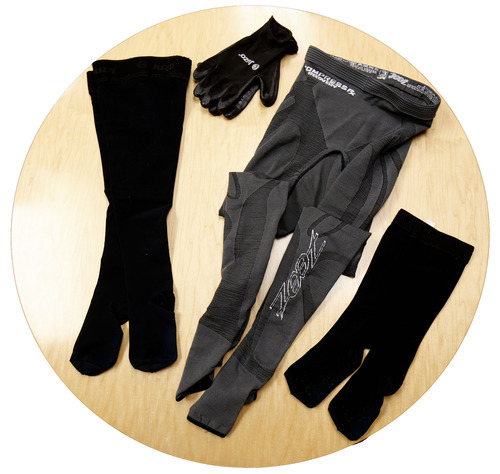This is an archived article that was published on sltrib.com in 2012, and information in the article may be outdated. It is provided only for personal research purposes and may not be reprinted.
Mountain-bike racer Sarah Kaufmann has a tried and true method for recovering from a big race.
First she has a recovery drink, then she eats and then she slips on a pair of thin, skin-hugging tights.
When Kaufmann takes off the tights an hour or so later, it's as if she has a new pair of legs.
The 30-year-old Ogden resident, who races at the professional level, is one of many athletes who are compression-tight converts.
For years, doctors have prescribed compression tights for patients with circulatory problems and to help decrease the chance of blood clots after surgery, but recently they have become popular among endurance athletes and football players. Even NBA players such as LeBron James, Kobe Bryant and Dwyane Wade tout their benefits.
Weekend warriors are jumping on the trend, too, making compression tights a hot seller. Numerous companies produce them, including Nike, Under Armour, Sugoi, Skins and Lin, a Utah company.
The commercial offerings look more impressive than the hospital versions but work on the same principle by using compression to aid fatigue.
Several studies, with mixed results, have been conducted to determine the effectiveness of the tights.
One study followed a group of well-trained cyclists who wore compression tights during a one-hour time trial. The cyclists showed increases in muscle oxygenation economy and improvements in cycling economy, according to the study, which tested the tights made by the Skins brand.
Another study, performed by the Australian Institute of Sport, found similar results when it tested tights by the 2XU brand. The cyclists had significantly lower heart rates when wearing the tights. They also had a greater reduction in blood lactate concentrations while wearing the tights during recovery. The study also showed an improved ability to maintain performance in a second cycling session after the first when wearing the tights for recovery.
Roger Petersen, the director of therapy services at The Orthopedic Specialty Hospital in Murray, is an advocate for compression tights. An avid cyclist who logs more than 4,000 miles a year, Petersen suffers from chronic venous insufficiency, a condition in which the veins can't pump enough blood back to the heart. Once debilitated by the pain of blood pooling in his extremities, Petersen is now pain-free when he wears the tights during activities and recovery.
"They keep your fluids flowing and give you a boost so you don't feel as sluggish or heavy," he said. "You feel more energetic because the blood is moving all the nutrients you need."
Petersen said that during activities, subtle trauma is taking place. "Compression can promote healing with the blood flow," he said, "so there are a lot of benefits to them from a therapy standpoint."
Kaufmann said she was sold on the benefits of compression tights after one race in which her legs hurt so badly she couldn't sleep.
After putting on the tights, her legs felt noticeably better after an hour. Now she uses a combination of the full-length tights and calf-length tights.
Many companies sell both kinds, but Kaufmann has opted for the medical-grade tights she gets at the pharmacy. They might not be as hip-looking as some designed by sport companies, she says, but they work just as well.
"I like them especially after hard rides or races," she said. "I often wear them on long travel days as well."
While not all studies show an improvement while wearing the tights, racers such as Kaufmann or Salt Lake City-based cyclo-cross racer Jim Noble continue to tout their benefits. Noble said the calf-length ones work for him, particularly on the days when he has to work.
"A lot of times I would end up spending most of an eight-hour shift standing following my training and racing," he said. "My legs always felt a lot lighter and fresher the next day after wearing my compression socks."





